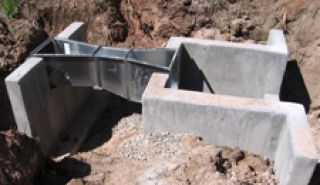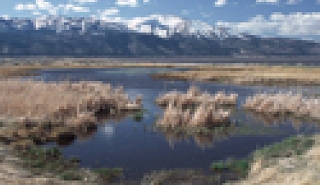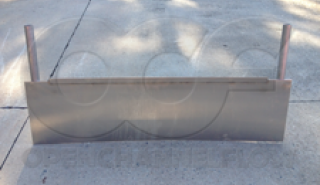Steel, while not used in wastewater applications, is a common material of construction for flumes used in water rights and irrigation applications. Both painted and galvanized steel are used for these applications; of the two, though, galvanized steel is the most common.

Painted Steel Flumes
Painted steel has two primary drawbacks - cost and longevity.
The cost of painted steel flumes is higher than their galvanized counterparts due to the need for two coats of protection - the primer coat and the finish coat. Galvanized steel flumes, on the other hand, are fabricated from hot galvanized sheet with the only supplementary protection required being the cold galvanization of welds and seams.
While the two stage protection of painted steel would seem to offer more protection than a single coat of galvanization, remember that the galvanization is applied under controlled factory conditions. The size of most flumes precludes the use of a paint booth, as such paint and prime is often applied on a shop floor - a less than optimal location.

Finally, there are no manufacturers who specialize in the flow measurement who also offer painted steel flumes. As such, any manufacturer offering them is not regularly engaged in the design, use, and application of such devices.
Galvanized Steel Flumes
Galvanized steel, then, has a clear advantage for water rights / irrigation flumes. Unfortunately not all galvanized flumes are created equal. There are several differentiating factors when comparing among galvanized flume manufacturers.
First and foremost is the expertise of the manufacturer. Like painted steel flumes, there are a number of regional manufacturers who offer galvanized steel flumes but who have little, if any, understanding of the application and use. In many cases a poorly applied flume is no better than no flume - and in some instances may actually create additional problems for the user.
Next comes the actual construction. This may seem straightforward, but there can be substantial differences between "identical" flumes from different manufacturers. Gauge thickness is the easiest to understand. While small flumes - those with throat widths of 3-inches and under - are constructed from 16 gauge sheet, larger flumes must be constructed from 12 to 7 gauge material - depending upon the flume size and installation.

External reinforcement (both in the form of dimensional angle and ribbing) is also important. Dimensional angle should be a minimum of 2-inch x 2-inch x 1/4-inch equal leg angle. For flumes with throats 48-inches and wider, this must be increased to 3-inch x 3-inch to provide sufficient rigidity.
While smaller flumes do not need external ribbing, flumes with throat widths 12-inches or greater should have external ribs welded to the outside of the flume along the inlet, throat, and discharge sections. Additionally, ribbing should be welded under the floor of the flume at the entrance and exit of the throat, as this is the most critical section.

The next construction note is whether or not the flume is actually welded together. This may sound like it is a given, but there are some flume manufacturers who form the elements of the flume and then just bolt them together - relying on adhesive / caulk to keep the flume watertight! While there are the occasional applications where multi-piece construction is required, these applications are few and far between in water rights / irrigation applications.

All seams should be bent from continuous sheet or have full factory welds (which should then be cold galvanized). Sealant is not recommended as is not always a positive seal and does not last as longer as bent / welded seams - particularly if the sealant is only applied along the surface of the seam.

While galvanized steel construction is superior to painted steel construction in many applicaitons, it does not, however, outperform painted steel when embedded in highly reducing soils (both organic and inorganic). Here the protective coating can fail in only a few years, the result being a rate of corrosion comparable to bare steel.





